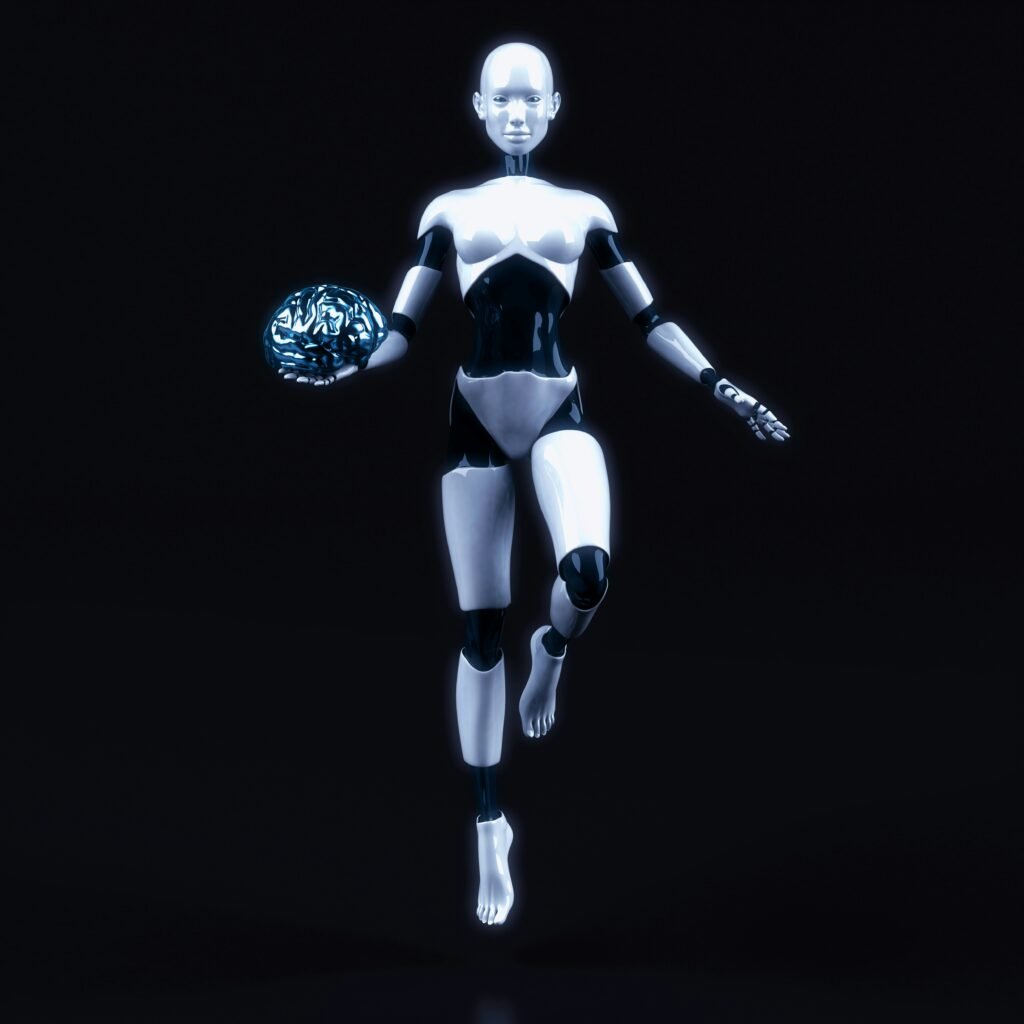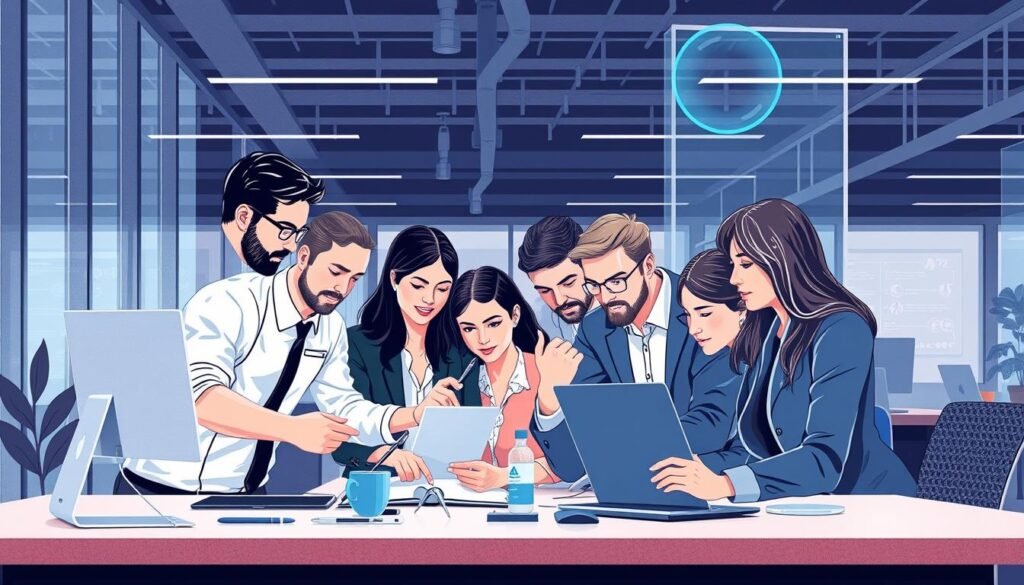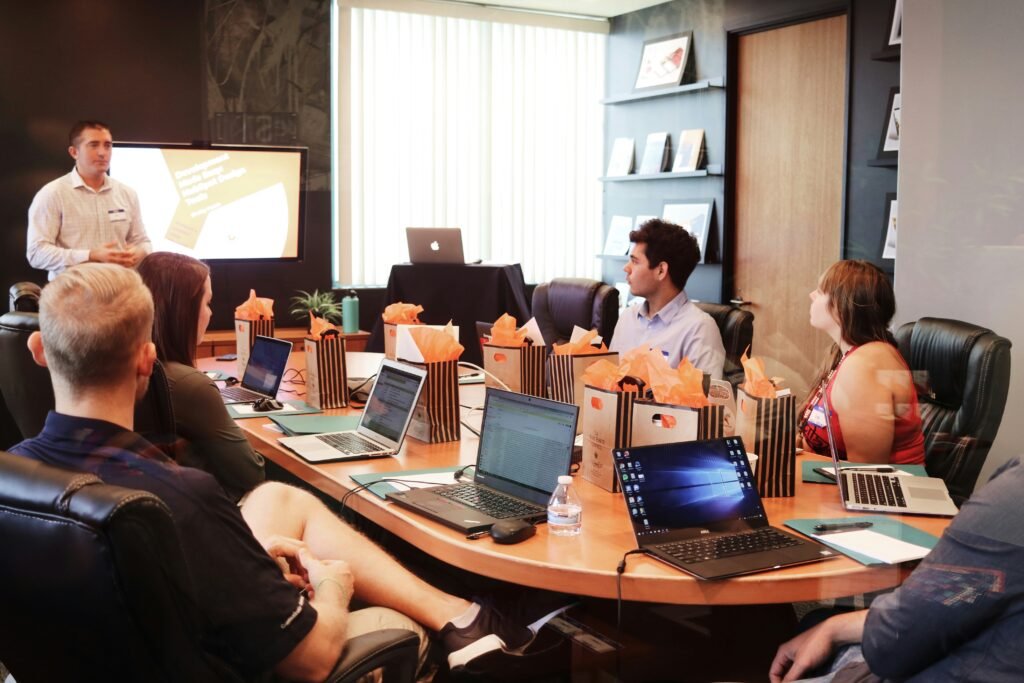The workplace is undergoing a significant transformation with the emergence of artificial intelligence in the form of digital employees. These highly skilled and technology-powered entities are designed to work alongside human colleagues, enhancing business operations and team collaboration.
Unlike traditional automation tools, AI workers can understand context, learn from interactions, and improve their performance over time. This represents a significant shift in how businesses operate, creating hybrid workforces that combine human creativity with AI efficiency.
As organizations across industries begin to integrate these digital employees into their teams, the workplace is set to undergo a revolutionary change, shaping the future of work.
Understanding AI Workers in Today’s Digital Landscape
The digital landscape is witnessing a significant shift with the emergence of AI workers. As technology advances, businesses are increasingly adopting digital employees to streamline their processes. This transformation is not just about automating simple tasks; it’s about integrating sophisticated intelligence into various aspects of work.

Defining AI Workers and Digital Employees
AI workers, also known as digital employees, are not just simple automation tools. They are advanced systems that combine different types of artificial intelligence to perform complex tasks. For instance, Typetone’s AI digital workers utilize a combination of generative AI and large language models (LLMs) to generate new content, understand human language, and interact meaningfully.
These digital workers are designed to handle a wide range of tasks, from data analysis to customer service, and are capable of learning and adapting over time. This adaptability is a significant advancement over traditional automation, which was limited to rule-based processes.
The Evolution from Simple Automation to Intelligent Agents
Over the years, the development of AI workers has come a long way. Initially, automation focused on repetitive and rule-based tasks. However, with advancements in intelligence and machine learning, modern AI workers can now handle unstructured data, make decisions, and learn from experience.
The integration of multiple AI technologies has enabled digital workers to perform increasingly complex tasks. Large language models have been particularly instrumental in enhancing AI workers’ ability to understand context and generate human-like responses.
How AI Workers Function in Modern Workplaces
As businesses evolve, AI workers are playing a crucial role in shaping the future of work. The functionality of AI workers in modern workplaces is rooted in their ability to learn, adapt, and improve over time. This capability allows them to become increasingly valuable assets to organizations.
The effectiveness of AI workers is driven by several core technologies.
Core Technologies Powering AI Workers
AI workers rely on advanced technologies such as machine learning algorithms, natural language processing, and data analytics to perform their tasks efficiently. These technologies enable AI workers to process vast amounts of data, recognize patterns, and make informed decisions.
| Technology | Functionality | Benefit |
|---|---|---|
| Machine Learning | Enables learning from experience | Improves task performance over time |
| Natural Language Processing | Facilitates human-AI interaction | Enhances quality of communication |
| Data Analytics | Analyzes large datasets | Provides valuable information for decision-making |
Learning and Adaptation Capabilities
One of the key features of AI workers is their ability to learn and adapt. Through continuous learning, AI workers can refine their approaches based on outcomes and feedback, leading to improved performance in various tasks. They can build specialized knowledge about an organization’s processes and preferences, making them more effective over time.
AI workers can learn from their mistakes, incorporating corrections to avoid similar errors in the future. The quality of their output improves as they process more information and receive guidance from human team members.

AI Workers vs. Traditional Bots: Key Differences
As businesses evolve, the role of AI workers is becoming increasingly distinct from that of traditional bots. The primary distinction lies in their capabilities and the value they bring to modern workplaces.
Beyond Rule-Based Automation
Traditional bots operate based on predefined rules and scripts, limiting their ability to adapt to new situations or learn from experience. In contrast, AI workers leverage machine learning and advanced data processing to “think” and offer innovative solutions. For example, an AI tool designed to respond to user prompts can’t necessarily account for context, tone, or unique brand values. However, AI employees can dive deep into past projects, input, and brand guidelines to create content optimized for business needs.
To illustrate the differences, consider the following comparison:
| Feature | Traditional Bots | AI Workers |
|---|---|---|
| Automation Basis | Rule-based | Machine Learning |
| Adaptability | Limited | High |
| Decision Making | Predefined scripts | Contextual understanding |
Context Understanding and Decision-Making Abilities
AI workers possess sophisticated context understanding capabilities, enabling them to grasp business nuances and adapt their responses accordingly. They can analyze available information, recognize patterns, and make informed decisions based on both explicit instructions and implicit context. This capability allows AI workers to create high-quality content that aligns with organizational identity and business objectives.
Some key features of AI workers include:
- The ability to understand brand voice and company values.
- Maintaining context across multiple interactions and projects.
- Identifying relevant data points from large information sets.
- Improving decision-making abilities through processing more examples and receiving feedback on work quality.

By understanding these differences, businesses can make informed decisions about when to use AI workers versus traditional bots, ultimately enhancing their operational efficiency and business outcomes.
The Current Landscape of AI Workers
The current landscape of AI workers is characterized by diverse applications and innovative solutions. As businesses continue to adopt AI technology, the role of AI workers in enhancing operational efficiency and customer satisfaction is becoming increasingly evident.

Popular AI Worker Platforms and Solutions
Several platforms are leading the way in AI worker technology. For instance, Typetone has designed AI employees that integrate seamlessly into existing teams, requiring only a few minutes to train and deploy. These AI digital workers simplify tasks, allowing human teams to focus on creative and meaningful actions that drive business success.
From data analysis to social media management and content creation, AI digital employees consistently deliver results without hassle. This versatility makes them valuable assets across various business functions.
Industries Leading AI Worker Adoption
Several industries are at the forefront of AI worker adoption. Customer service and support has emerged as a leading sector, with digital employees handling inquiries, providing information, and resolving issues efficiently.
- Financial services organizations are implementing AI workers for data analysis, fraud detection, and personalized customer interactions.
- Marketing and content creation teams are leveraging AI workers to generate content, analyze campaign performance, and manage social media presence.
- Sales teams are using AI workers to qualify leads, manage customer relationships, and provide sales analytics.
- E-commerce businesses are implementing AI workers for inventory management and personalized recommendations.
- Legal and compliance departments are utilizing AI workers for document review and contract analysis.
These examples illustrate the diverse applications of AI workers across industries, highlighting their potential to transform business operations and enhance customer experiences.
The Impact of AI Workers on Employment
The growing presence of AI in the workplace is sparking debates about its implications for jobs. As organizations increasingly adopt AI workers, concerns about job displacement and the future of employment are becoming more pronounced.
Job Displacement Concerns and Realities
The introduction of AI workers has raised concerns about potential job displacement. According to the Tony Blair Institute, up to 3 million private sector jobs in the UK could be displaced due to AI. However, the institute also estimates that the actual job losses will be significantly lower, numbering in the low hundreds of thousands, as AI will also create new job opportunities.
The impact of AI on employment is complex. While AI may automate certain tasks, it is also expected to augment human capabilities, leading to the creation of new roles and enhancing productivity. For instance, AI can take over routine and repetitive tasks, freeing human workers to focus on more complex and creative endeavors.
| Industry | Potential Job Displacement | New Job Creation |
|---|---|---|
| Manufacturing | Production Line Workers | AI Maintenance Technicians |
| Customer Service | Call Center Representatives | AI Trainer Specialists |
| Data Analysis | Data Entry Clerks | AI Data Analysts |
New Roles Created by AI Integration
As AI workers become more prevalent, new job categories are emerging that focus on managing, training, and optimizing these digital employees. Roles such as AI trainers, who specialize in teaching AI systems, and AI ethics specialists, who ensure AI operates according to ethical guidelines, are becoming increasingly important.
Other new roles include teams dedicated to AI integration and workflow design, professionals skilled in human-AI collaboration, and domain experts who provide specialized knowledge to AI systems. For example, the role of “AI trainers” is a growing career path that didn’t exist before, highlighting the evolving nature of work in an AI-driven landscape.

The shift toward AI workers is creating demand for professionals who can identify tasks suitable for automation and those requiring human judgment. As AI continues to integrate into the workplace, the need for skills that complement AI, such as critical thinking and creativity, will become more pronounced.
Becoming an “Agent Boss”: Managing AI Workers
The rise of AI workers is transforming the workplace, introducing a new leadership role: the ‘Agent Boss.’ As organizations increasingly integrate AI into their operations, the ability to manage these digital employees effectively becomes crucial. This new role requires a blend of technical understanding and leadership skills to maximize the potential of AI workers.

Skills Needed to Direct AI Teams
To direct AI teams successfully, ‘Agent Bosses’ need to possess a unique set of skills. They must understand how to assign tasks effectively, leveraging the strengths of both human and AI workers. This involves developing clear protocols for task assignment and establishing which responsibilities are best handled by AI versus human team members. Moreover, ‘Agent Bosses’ should be adept at analyzing performance data to refine their management strategies and enhance productivity.
Effective ‘Agent Bosses’ also need to be skilled in creating feedback loops between humans and AI workers. This ensures continuous improvement and involves regular review points built into workflows. By doing so, they can identify areas for improvement and implement adjustments to optimize business processes.
Establishing Effective Human-AI Workflows
Creating effective human-AI workflows is critical for maximizing efficiency and achieving business objectives. This requires rethinking traditional processes to leverage the strengths of both human and digital employees. Organizations must establish clear communication channels between AI workers and human team members to maintain alignment and coordination across projects.
Moreover, managing time effectively becomes a new dimension as organizations balance the 24/7 availability of AI workers with human work schedules and productivity needs. By implementing these strategies, ‘Agent Bosses’ can ensure seamless integration of AI workers into their teams, driving overall efficiency and enhancing organizational performance.
Case Studies: AI Workers in Action
Businesses are increasingly leveraging AI workers to enhance productivity and drive growth. This integration is evident across various sectors, with AI workers proving their value in multiple applications.
Customer Support and Sales AI Workers
AI workers like Soshie, the Social Media Manager, are revolutionizing customer support and sales by automating tasks such as content generation, strategy planning, and trend identification. For example, companies using AI for customer support report improved response times and customer satisfaction. These AI workers can handle a significant volume of inquiries, freeing human resources for more complex issues.
The implementation of AI in sales processes has also shown promising results, with AI systems capable of analyzing customer data to predict sales trends and personalize marketing efforts.

Data Analysis and Content Creation AI Workers
AI workers such as Dexter, the Data Analyst, and Penn, the Copywriter, are making significant impacts in data analysis and content creation. Dexter transforms complex data into actionable business insights, while Penn generates compelling content for various marketing campaigns.
Organizations are benefiting from the ability of AI workers to process vast amounts of information quickly, identify patterns, and generate insights at unprecedented speeds. This capability is particularly valuable in business environments where data-driven decisions are crucial. Additionally, AI-generated content is helping companies maintain a consistent brand voice across large content projects, enhancing overall productivity.
The Future of Work with AI Employees
With AI technology advancing rapidly, the concept of work and workplace is undergoing a significant transformation. As organizations continue to adopt AI solutions, the role of AI employees in the workplace is expected to expand dramatically.
Microsoft has made significant predictions regarding the future of AI in the workplace, particularly with the emergence of what they term “Frontier Firms.” This concept is closely tied to the evolving role of AI workers and their integration into various industries.
Microsoft’s “Frontier Firms” Prediction
Microsoft’s vision for the future includes the rise of “Frontier Firms” that will lead the way in AI adoption. According to their report, these firms will be at the forefront of leveraging AI technology to transform their workplaces and operations. The prediction emphasizes the importance of AI assistants for every employee, marking the beginning of a new era in workplace productivity.
The report highlights that the impact of AI on knowledge work will mirror its influence on software development, evolving from mere coding assistance to agents capable of carrying out complex tasks independently.
The Three-Phase Evolution of Workplace AI
The evolution of workplace AI is anticipated to unfold in three distinct phases. Initially, every employee will be equipped with a personal AI assistant to enhance their productivity. In the second phase, AI agents will join existing teams as “digital colleagues,” taking on specific tasks and collaborating with human employees.
The final phase will see humans primarily setting directions and objectives while AI agents execute entire workflows and business processes with minimal supervision. This phase will revolutionize how tasks are managed and completed in the workplace.
| Phase | Description | Impact on Workplace |
|---|---|---|
| 1 | Personal AI Assistants | Enhanced Employee Productivity |
| 2 | AI Agents as Digital Colleagues | Collaboration between Humans and AI |
| 3 | AI Agents Executing Workflows | Autonomous Task Management |
As AI continues to evolve and become more integrated into the workplace, organizations that understand and prepare for these changes will be better positioned to capture the benefits of workplace AI. The future of work will undoubtedly be shaped by the capabilities and limitations of AI employees, leading to new opportunities and challenges in the workplace.
Conclusion: Preparing for an AI-Augmented Workforce
The future of work is being reshaped by AI workers, and companies that embrace this change will be better positioned for success. As AI continues to advance, it’s crucial for business leaders to develop strategic approaches to integrating AI workers into their workplace.
One of the key challenges is determining which tasks are best suited for AI workers versus human employees, creating complementary workflows rather than competitive ones. This requires investment in both technology solutions and human skill development, ensuring employees can effectively collaborate with their digital counterparts.
Organizations should anticipate significant changes to team structures, management practices, and performance metrics as AI workers become more prevalent in the coming years. While AI workers will undoubtedly have an impact on employment patterns, they also create opportunities for human workers to focus on higher-value activities that leverage uniquely human capabilities.
To navigate this transformation, maintaining a balance that preserves human knowledge, creativity, and relationship-building capabilities while leveraging AI efficiency will be crucial for sustainable business success. For more insights on preparing for an AI-augmented workforce, visit https://www.vktr.com/ai-upskilling/how-companies-can-prepare-for-an-ai-augmented-workforce/ and explore resources on https://enterprisal.com/ to stay ahead in the evolving workplace.
As we move forward, the most successful companies will be those that thoughtfully integrate AI workers into their operations and culture, enhancing productivity and driving innovation. The rise of AI workers represents not just a technological shift but a fundamental reimagining of how work gets done in the modern world.

